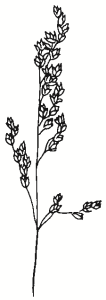Family:
Poaceae
Poa spp.
Tussock Grasses
Other Names:
First Nations Name(s):

Regional Subspecies:
Occurrence:
Regional:
Widespread and common throughout region.
Habit:
Tufted annuals or perennials, often forming large tussocks. Sometimes with rhizomes or stolons, generally flowering spring.
Similar Species:
Species in the region include P. labillardieri — Tussock Grass and P. sieberiana — Fine-leaf Tussock Grass.
Seed Collection:
Small seeds in tall finely-branched seedheads turn from green to light brown as seeds mature.
Propagation:
From seed, or division which is easier. Stratifying seed for 3 weeks may improve germination.
VALUES:
Land Protection:
Useful for controlling soil erosion.
Wildlife:
Good habitat. Useful refuge for small native birds and reptiles. Important habitat for insects, including butterflies, and seeds are a food for native birds.
Ornamental:
Attractive grasses for rockeries and other gardens. Plant in groups for best effect. Rejuvenate old plants by cutting back severely, or burning. Water heavily afterwards to encourage growth.
Other:
Some species valuable fodder.
